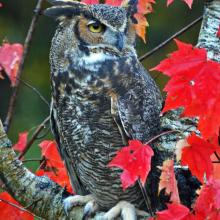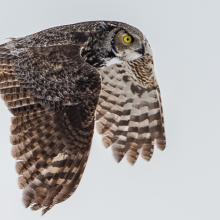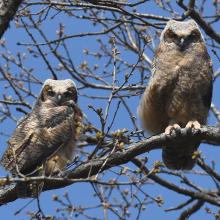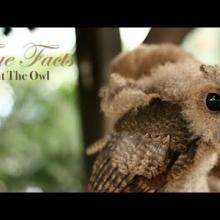

Join BirdNote tomorrow, November 30th!
Illustrator David Sibley and actor H. Jon Benjamin will face off in the bird illustration battle of the century during BirdNote's Year-end Celebration and Auction!
A fledgling Great Horned Owl calls to be fed. Judging from the young bird's persistence, the parents seem to be responding only with calls, not with food. These entreaties can go on for weeks. Both parents let the fledgling know that it's time for him to feed himself. They've been bringing voles and rabbits for months. Silence and surprise are keys to the owls' success as hunters, so it's hard to imagine the juvenile Great Horned Owl improving his chances by being so vocal!
BirdNote®
Great Horned Owls Calling
Written by Chris Peterson
This is BirdNote!
[Calls of Great Horned Owl juvenile and parents Track 202:27]
Let’s eavesdrop on a family of Great Horned Owls. Here, a fledgling is calling to be fed. And judging from the young bird’s persistence, the parents seem to be responding only with calls, not food. [Wheezy calls of the juvenile Great Horned Owl interspersed with adult calls Track 202 1:34]
Hoots of the male Great Horned Owl are lower in pitch than those of the female. [Deeper hoot of the male, followed by higher hoot of the female]. Now listen for the moment the female flies in to join the male:
[Conversation of male and female Great Horned Owls just as the female flies up]
Days later, about eleven P.M., we hear the juvenile calling again. In fact, these entreaties can go on for weeks.
[Wheezy calls of juvenile Great Horned Owl and response of female parent]
We’re hearing the female respond, but both parents seem to be making the point that it’s time for junior to feed himself. They’ve been bringing voles and rabbits for months. Silence and surprise are keys to their success as hunters, so it’s hard to imagine the juvenile improving his chances by being so loud! [Screech of juvenile, T202 1:11]
We can guess what the parents are conveying, but wouldn’t it be fun to know for sure!
[Calls of male and female Great Horned Owls]
For BirdNote, I’m Mary McCann.
###
All Great Horned Owl calls recorded by C. Peterson at French Road.
Producer: John Kessler
Executive Producer: Chris Peterson
© 2014 Tune In to Nature.org November 2018/2020/2022 Narrator: Mary McCann
ID# GHOW-10-2011-11-15










